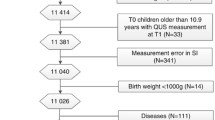Abstract
Urinary excretion of pyridinium crosslinks of collagen, pyridinoline, deoxypyridinoline, andN-terminal crosslinked peptide are now widely used as biochemical markers of bone resorption. In the present cross-sectional study we measured the urinary excretion of total pyridinoline and total deoxypyridinoline by HPLC andN-terminal crosslinked peptide by ELISA in 43 preterm and term newborns in the first 2 months of life. The infants had no history of endocrine or metabolic diseases, bone, chronic heart, or pulmonary diseases. The results were compared by parametric covariance analysis, the HPLC and ELISA results by the Bland-Altman plot. Preterm infants had a statistically higher level of pyridinium crosslinks andN-terminal crosslinked peptide in urine (P<0.05) than term infants. The very low birthweight infants (gestational age 26–32 weeks) had the highest levels of pyridinoline, deoxypyridinoline andN-terminal crosslinked peptide. Levels of both pyridinium crosslinks and /N-terminal crosslinked peptide were independent of sex (P>0.05). The Bland-Altman plot showed a good agreement between the levels of pyridinium crosslinks andN-terminal crosslinked peptide. Measurement of pyridinium crosslinks andN-terminal crosslinked peptide excretion in small infants gives information about skeletal growth and individual bone turnover, which is dependent on gestational age and birthweight. HPLC and ELISA are reliable methods for the measurement of pyridinium crosslinks andN-terminal crosslinked peptide, respectively.
Similar content being viewed by others
References
Greer F, McCormick A. Improved bone mineralization and growth in premature infants fed fortified own mother’s milk. J Pediatr 1988; 112:961.
Pittard W, Geddes K, Sutherland S, Miller M, Hollis B. Longitudinal changes in the bone mineral content of term and premature infants. àm S Dis Child 1990; 144:36.
Body J, Delmas P. Urinary pyridinium cross-links as markers of bone resorption in tumor-associated hypercalcemia. J Clin Endocrinol Metab 1992; 74:471.
Coleman R, Houston S, James I, Rodger A, Rubens R, Leonard R, Ford J. Preliminary results of the use of urinary excretion of pyridinium crosslinks for monitoring metastatic bone disease. Br J Cancer 1992; 65:766.
Colwell A, Russell R, Eastell R. Factors affecting the assayof urinary 3-hydroxy pyridinium crosslinks of collagen as markers of bone resorption. Eur J Clin Invest 1993; 23: 341.
Eyre D, Dickson I, Van Ness K. Collagen crosslinking in human bone and articular cartilage. J Biochem 1988: 252:495.
Hashimoto K, Nozaki M, Yokoyama M, Sano M, Nakano H. Urinary excretion of pyridinium crosslinks of collagen in oophorectomized women as markers for bone resorption. Maturitas 1994; 18: 135.
Kamel S, Brazier M, Picard C, Boitte F, Samson L, Desmet G, Sebert J. Urinary excretion of pyridinolines crosslinks measured by immunoassay and HPLC techniques in normal subjects and in elderiy patients with vitamin D deficiency. Bone Miner 1994; 16:197.
Seibel M, Zipf A, Ziegler R. Pyridinium-crosslinks im Urin. Dtsch Med Wochenschr 1994; 119:923.
Tsukahara H, Miura M, Hori C, Hiraoka M, Nosaka K, Hata K, Konishi Y, Sudo M. Urinary excretion of pyridinium crosslinks of collagen in infancy. Metabolism 1996; 45:510.
James IT, Walne AJ, Perrett D. The measurement of pyridinium crosslinks: a methodological overview. Ann Clin Biochem 1996; 33:397.
Eyre D, Paz M, Galop P. Cross linking in collagen and elastin. Annu Rev Biochem 1984; 53:717.
Delmas P. Biochemical markers of bone turnover I: theoretical considerations and clinical use in osteoporosis. Am J Med 1993: 95 [Suppl 5 A]: 11S.
Hanson D, Weis M, Bollen A, Maslan S, Singer F, Eyre D. A specific immunoassay for monitoring human bone resorption: quantitation of type I collagen cross-linked N-telopeptides in urine. J Bone Miner Res 1992; 7: 1251.
Bollen A, Eyre D. Bone resorption rates in children monitored by the urinary assay of collagen type I cross-linked peptides. Bone 1994; 15: 31.
Fujimoto S, Kubo T, Tanaka H, Miura M. Urinary pyridinoline and deoxypyridinoline in healthy children with growth hormone deficiency. J Clin Endocrinol Metab 1995; 80: 1922.
Uebelhart D, Gineyts E, Chapuy M, Delams P. Urinary exretion of pyridinium crosslinks: a new marker of bone resorption in metabolic bone disease. Bone Miner 1990; 8; 87.
Bland JM, Altman DG. Comparing methods of measurement: why plotting difference against standard method is misleading. Lancet 1995: 346: 1085.
Bettica P, Moro L, Robins S, Taylor A, Talbot J, Singer F, Baylink D. Bone-resorption markers galactosyl hydroxylysine, pyridinium crosslinks, and hydroxyproline compared. Clin Chem 1992; 38:2313.
Rauch F, Schönau E, Woitge H, Remer T, Seibel M. Urinary excretion of hydroxy-pyridinium cross-links of collagen reflects skeletal growth velocity in normal children. Exp Clin Endocrinol 1994; 102:94.
McLaren A, Hordon L, Bird H, Robins S. Urinary excretion of pyridinium crosslinks of collagen in patients with osteoporosis and the effects of bone fracture. Ann Rheum Dis 1992; 51: 648.
Robins S, Hamilton N, Nicol P, Boschitsch E, Endler T, Seibel M. Bone resorption rates in pre-, peri- and postmenopausal women determined by direct immunoassy of deoxypyridinoline. J Bone Miner Res 1994; 9: 1643.
Seibel M, Woitge H, Schneidt-Nave C, Leidig-Bruckner G. Dunca A, Nicol R, Ziegler R, Robins S. Urinary hydroxypyridinium crosslinks of collagen in population-based screening for overt vertebral osteoporosis: results of a pilot study. J Bone Miner Res 1994; 9: 1433.
Seyedin S, Kung V, Daniloff Y, Hesley R, Gomez B, Nielsen L, Rosen H, Zuk R. Immunoassay for urinary pyridinoline: the new marker of bone resorption. J Bone Miner Res 1993; 8: 635.
Robins S, Woitge H, Hesley R, Ju J, Seyedin S, Seibel M. Direct, enzyme-linked immunoassay for urinary deoxypyridinoline as a specific marker for measuring bone resorption. J Bone Miner Res 1994; 9: 1643.
Author information
Authors and Affiliations
Rights and permissions
About this article
Cite this article
Gfatter, R., Braun, F., Herkner, K. et al. Urinary excretion of pyridinium crosslinks andN-terminal crosslinked peptide in preterm and term infants. Int J Clin Lab Res 27, 238–243 (1997). https://doi.org/10.1007/BF02912464
Received:
Accepted:
Issue Date:
DOI: https://doi.org/10.1007/BF02912464




